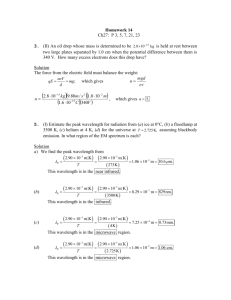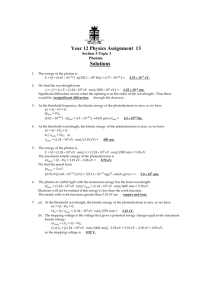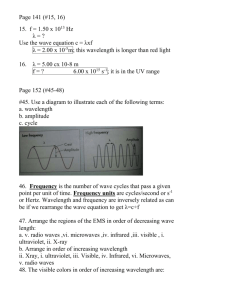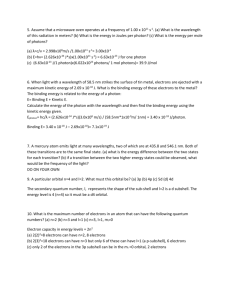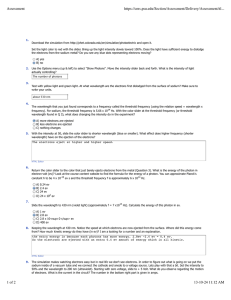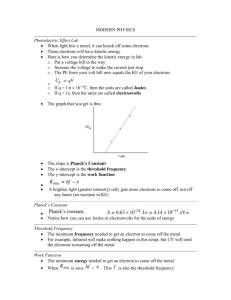Worksheet - The Photoelectric Effect (Key)
advertisement
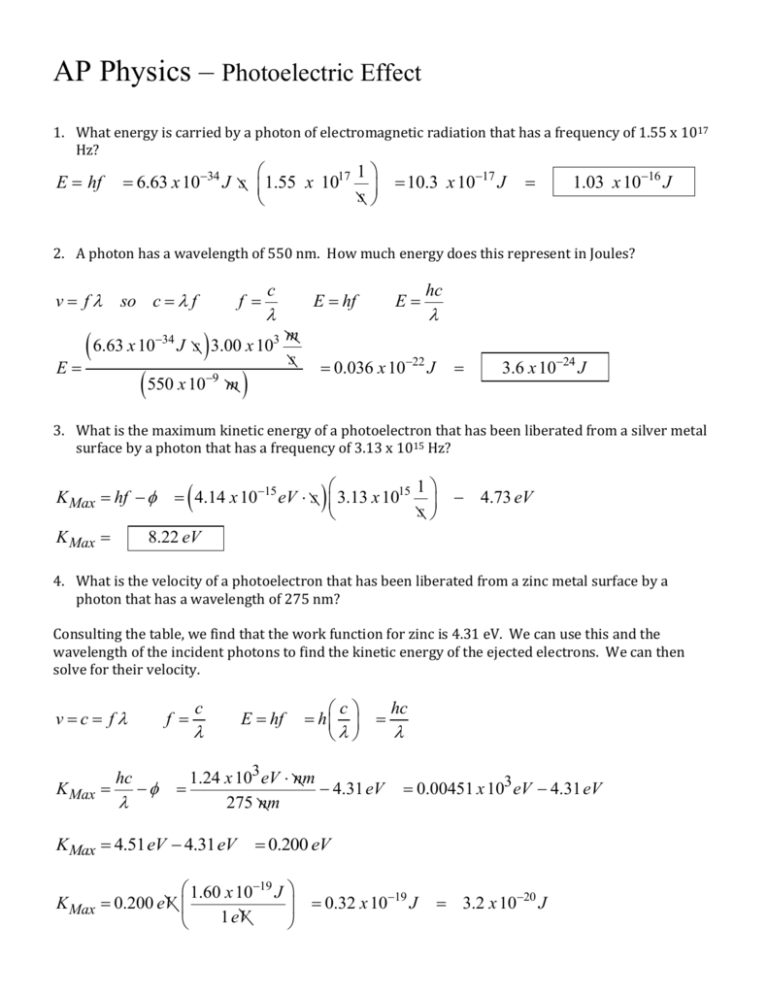
AP Physics – Photoelectric Effect 1. What energy is carried by a photon of electromagnetic radiation that has a frequency of 1.55 x 1017 Hz? E hf 1 6.63 x 1034 J s 1.55 x 1017 10.3 x 1017 J s 1.03 x 1016 J 2. A photon has a wavelength of 550 nm. How much energy does this represent in Joules? v f so c f f c 6.63 x 10 J s 3.00 x 10 E 550 x 10 m 34 E hf 3 9 m s E hc 0.036 x 1022 J 3.6 x 1024 J 3. What is the maximum kinetic energy of a photoelectron that has been liberated from a silver metal surface by a photon that has a frequency of 3.13 x 1015 Hz? 1 4.14 x 1015 eV s 3.13 x 1015 4.73 eV s 8.22 eV K Max hf K Max 4. What is the velocity of a photoelectron that has been liberated from a zinc metal surface by a photon that has a wavelength of 275 nm? Consulting the table, we find that the work function for zinc is 4.31 eV. We can use this and the wavelength of the incident photons to find the kinetic energy of the ejected electrons. We can then solve for their velocity. vc f K Max hc f c E hf hc c h 1.24 x 103 eV nm 4.31 eV 275 nm KMax 4.51 eV 4.31 eV 0.00451 x 103 eV 4.31 eV 0.200 eV 1.60 x 1019 J 19 K Max 0.200 eV 0.32 x 10 J 1 eV 3.2 x 1020 J 2 20 kg m 2 3.2 x 10 2 s 2K v v 31 m 9.11 x 10 kg 1 K mv 2 2 m2 v 0.7025 x 10 2 s 11 m2 7.025 x 10 s2 10 2.65 x 105 m s 5. What is the cutoff wavelength for a copper metal surface? C hc 1.24 x 103 eV nm 4.70 eV 0.264 x 103 nm 264 nm 6. 500.0 nm light is incident on a metal surface. The stopping potential is found to be 0.440 V. (a) Find the work function for this material and (b) the longest wavelength that will eject electrons from the metal. (a) work function: c f E hf K Max hc f K Max qV c E h c qV hc hc hc qV Now, when we plug in our values, we will stick in the symbol “e” for the charge of an electron. This will get us eV as a unit, eventually. 1.24 x 103 eV nm e 0.440 V 0.00248 x 103 eV 0.440 eV 500 nm 2.48 eV 0.440 eV 2.04 eV (b) longest wavelength Set the maximum kinetic energy equal to zero to get the longest wavelength. K Max hc 0 1.24 x 103 eV nm 204 eV hc hc 0.00608 x 103 nm hc 608 nm 7. CHALLENGE!: A sodium photoelectric surface with work function 2.3 eV is illuminated by electromagnetic radiation and emits electrons. The electrons travel toward a negatively charged cathode and complete the circuit shown above. The potential difference supplied by the power supply is increased, and when it reaches 4.5 V, no electrons reach the cathode. (a) For the electrons emitted from the sodium surface, calculate the following. i. The maximum kinetic energy. K Max qV K Max 1.6 x 1019 C 4.5 V 7.2 x 1019 J 1 eV K Max 7.2 x 1019 J 19 1.60 x 10 J ii. or 4.5 eV The speed at this maximum kinetic energy. 1 K mv 2 2 2 19 kg m 2 7.2 x 10 2 s 31 9.11 x 10 kg 2K m v 1.26 x 106 m s (b) Calculate the wavelength of the radiation that is incident on the sodium surface. K Max h hc c E h c c h K Max h K Max c f E hf c f hc K Max c 1.24 x 103 eV nm 4.5 eV 2.3 eV 0.182 x 103 nm 182 nm (c) Calculate the minimum frequency of light that will cause photoemission from this sodium surface. KMax hf But 0 hf hf KMax 0 for the minimum frequency, so f h f 2.3 eV 4.14 x 1015 eV s 0.555 x 1015 Hz 5.55 x 1014 Hz
